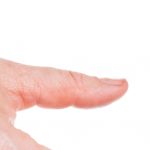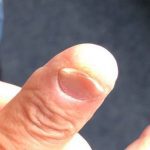How Can We Help?
Koilonychia
2.8k Views
What is Koilonychia?
Koilonychia, commonly referred to as ‘spoon nails’, is a condition where the nails lose their natural convex shape due to extreme thinning. Instead of being curved, the nails appear flat or concave, forming a spoon-like appearance. Affected nails are often soft, thin, and fragile, making them more prone to breakage and they are usually missing part of the nail grove in the lateral nail folds.
This condition is not a defect in itself it is a symptom that typically involves changes in the nail matrix, nail bed, and or the nail plate. While it can affect both fingernails and toenails, it is most commonly seen in the fingernails. In some cases, koilonychia may also cause the nails to become softer and slow-growing typically with an indentation that is deep enough to hold a drop of water in your nail plate.
Causes of Koilonychia
Koilonychia can develop due to a variety of underlying medical conditions or external factors. Some of the most common causes include:
✔ Iron Deficiency Anemia – One of the leading causes of koilonychia, iron deficiency weakens the nails, preventing them from forming a healthy structure. Low iron levels reduce oxygen supply to the nail matrix, affecting nail growth and shape.
✔ Nutritional Deficiencies – A lack of essential nutrients like protein, folic acid, and vitamin C can contribute to weak and deformed nails. Malnutrition, often seen in individuals with poor dietary habits or underlying health conditions, can be a significant factor.
✔ Autoimmune Conditions – Diseases like bệnh liken phẳng, an autoimmune disorder that affects the skin and nails, can lead to changes in the nail structure, including thinning and spooning.
✔ Systemic Illnesses – Conditions such as syphilis, hypothyroidism, or hemochromatosis (excess iron absorption) can also cause koilonychia as a secondary symptom.
✔ Genetic Factors – Some individuals may inherit koilonychia as a congenital condition. In these cases, spoon nails may appear in infancy and continue into adulthood.
✔ Repeated Trauma or Environmental Factors – Continuous exposure to chemicals, detergents, or excessive moisture can weaken the nail structure. People who frequently immerse their hands in water, such as hairdressers or cleaners, are more prone to developing spoon nails.
✔ Nail Disorders and Fungal Infections – Certain nail infections or conditions affecting nail growth can also lead to abnormalities, including koilonychia.
Who is Most at Risk?
Koilonychia can affect anyone, but it is more common in individuals who:
🔹 Suffer from iron deficiency anemia hoặc malnutrition.
🔹 Have chronic illnesses affecting blood circulation or metabolism.
🔹 Are frequently exposed to chemicals, harsh detergents, or prolonged moisture.
🔹 Have a family history of congenital koilonychia.
Certain age groups are also more susceptible. Infants may be born with spoon nails, but this often corrects itself as they grow. On the other hand, elderly individuals with weakened circulation or chronic conditions may develop the condition later in life.
How is Koilonychia Diagnosed?
A medical professional can diagnose koilonychia through a physical examination of the nails and a review of the patient’s medical history. If an underlying condition is suspected, additional blood tests may be required to check for iron levels, thyroid function, or signs of infection.
In some cases, a biopsy of the nail bed may be performed to rule out more serious conditions affecting nail growth.
Treatment for Koilonychia
The treatment of koilonychia primarily focuses on addressing the underlying cause. Depending on the diagnosis, a medical professional may recommend:
✔ Iron Supplements & Dietary Changes – If iron deficiency anemia is the cause, increasing iron intake through supplements or iron-rich foods like spinach, red meat, lentils, and nuts can improve nail health.
✔ Medical Treatment for Systemic Conditions – If koilonychia is linked to conditions like hypothyroidism or autoimmune diseases, proper medical treatment of the underlying illness may help restore normal nail growth.
✔ Topical or Oral Medications – In cases of nhiễm trùng nấm hoặc skin-related disorders, doctors may prescribe antifungal creams or oral medications.
✔ Lifestyle Adjustments – Reducing exposure to harsh chemicals, wearing protective gloves, and keeping nails moisturized can prevent further damage and promote a closer to normal nail growth.
In cases where the condition is genetic or congenital, medical treatment may not be necessary, and the nails may improve naturally over time.
How Can a Nail Technician Help?
Although koilonychia requires medical intervention, nail technicians can still provide safe and professional chăm sóc móng tay for clients with this condition.
✔ Gentle Manicures & Pedicures – – The nails are thin, soft and fragile, so treatments should be performed carefully to avoid further damage. Tránh xa filing or buffing the nail plates surface as this will weaken the nail plate structure further.
✔ Moisturization & Nail Protection – Recommending hydrating nail and cuticle oils can help improve nail flexibility and reduce brittleness.
✔ Using Non-Damaging Nail Products – Avoid using harsh chemical removers, or aggressive manicure techniques that will weaken the nails further.
✔ Educating Clients on Nail Health – Clients should be encouraged to seek medical advice if their nails show signs of severe thinning, discolouration, or unusual changes.
Suy nghĩ cuối cùng
Koilonychia is often a sign of an underlying nutritional deficiency, health condition, or environmental factor. While nail technicians can provide supportive care, only a medical professional can diagnose and treat the root cause.
Clients experiencing symptoms of koilonychia should seek medical evaluation, especially if they notice additional health concerns or if the client would like to use artificial nail products to improve the aesthetics of the nail, make sure there are no contraindications that may make matters worse – If no contraindication is present remember: Only use flexible artificial nail products and if you are filling the ‘dip’ in the nail with gel or gel polish use thin layers and cure in between layers to guarantee a proper cure. A flexible acryl Liquid & Powder system is a smart product to use as this removes any risk of ‘under-cure’ AND it can be removed safely with a matching soak-off product remover.
Thư viện hình ảnh



